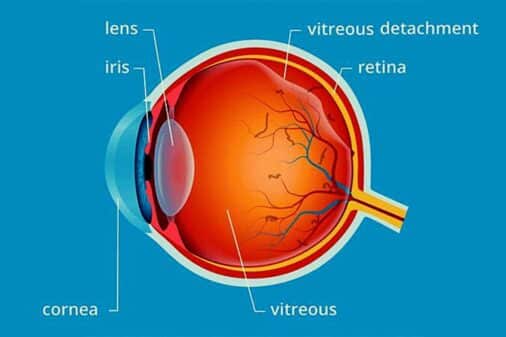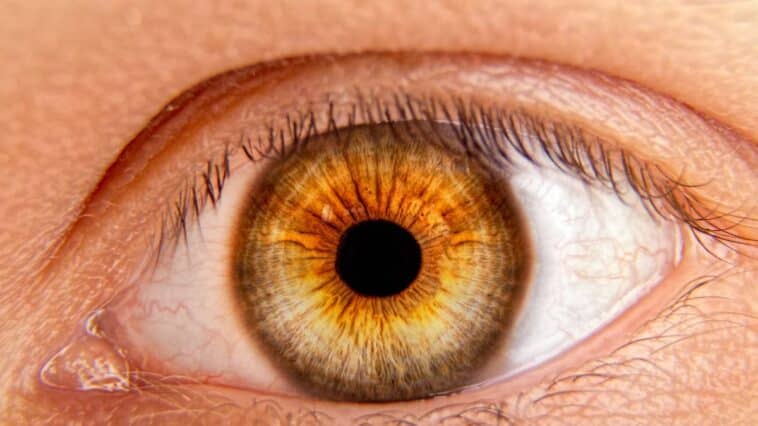What Is The Vitreous Humor?
Vitreous humor is a clear and gelatinous substance found at the back of the eye between the lens and retina. It helps maintain the eyeball’s shape and allows light to enter through its transparent structure. The vitreous comprises water, protein fibers, salts, and other molecules, making up 98% of its composition.
The vitreous is mainly made up of transparent water, allowing light to pass through it and reach the retina so that we can see. It is essential for the eye’s health; any vitreous problems can cause vision problems.

The Function Of Vitreous Humor
The vitreous humor, also known as the vitreous gel or simply the vitreous, has several vital functions in the eye:
- Maintaining the shape of the eye: The vitreous helps to maintain the shape of the eye by providing structural support.
- Supporting the retina: The vitreous humor, also known as the vitreous body. It helps to support the retina, a light-sensitive layer that sends visual signals to the brain.
- Allowing light to pass through: The vitreous is mostly made up of transparent water, allowing light to pass through and reach the retina.
- Protecting the eye: The vitreous helps support and protect the structures within the eye, including the lens and retina. Additionally, it helps provide a cushion for them by filling in the space between them and preventing them from rubbing against each other.
- Providing nutrients: The vitreous supplies nutrients to the retina and other structures in the eye.
- Absorbing shock: The vitreous serves the vital role of absorbing shockwaves and preventing them from getting transmitted to the eye’s delicate tissues. This protective function helps keep the eye structures safe from any potential harm.
Vitreous Conditions
Several conditions can affect the vitreous humor, also known as the vitreous gel or simply the vitreous, and cause vision problems or other eye-related issues. Some of the more common vitreous conditions include:
Vitreous Detachment
Vitreous detachment is a condition in which the vitreous separates from the retina. This can cause floaters and flashes of light in the field of vision.
There are two types of vitreous detachment:
- Posterior vitreous detachment (PVD): As we age, this normally transparent jelly may become cloudy, leading to posterior vitreous detachment (PVD). Flashes or floaters characterize PVD in our vision which can be concerning but is usually harmless.
- Anterior vitreous detachment (AVD): Vitreous humor is a clear, colorless, jelly-like material that fills two-thirds of the eye’s interior behind the lens. It is attached to the retina in several places and helps maintain its shape. Anterior vitreous detachment (AVD) occurs when this humoral material separates from the lens at the front of the eye. This can cause changes in vision or other associated symptoms.
Most people with vitreous detachment do not experience vision loss or other serious problems. However, seeing an eye doctor if you experience floaters or flashes of light is essential, as these may be symptoms of a more severe condition, such as a retinal detachment. Early treatment can help prevent further vision loss or other complications.
Vitreous Hemorrhage
Vitreous humor is the transparent, jelly-like substance that makes up the largest portion of the eyeball. It consists of proteins and mucopolysaccharides that help shape and protect the eye. Sometimes, a vitreous hemorrhage can occur, where blood enters the vitreous chamber and causes symptoms such as floaters and flashes of light across your vision.
There are several potential causes of vitreous hemorrhage, including:
- Diabetes: High blood sugar levels can cause small blood vessels in the eye to leak.
- High blood pressure: This can lead to these vessels becoming ruptured, which can cause fluids to leak and cause damage to the delicate structures in the eye.
- Trauma: A blow to the eye or head can cause bleeding in the vitreous.
- Eye surgery: Vitreous hemorrhage can sometimes occur after eye surgery.
- Other eye conditions: Vitreous hemorrhage can also be caused by other eye conditions, such as age-related macular degeneration or retinal detachment.
If you experience any symptoms of vitreous hemorrhages, such as vision loss or floaters, it is essential to see an eye doctor as soon as possible. Early treatment can help prevent further vision loss or other complications.
Retinal Tear
Vitreous humor is an essential part of the eye, between the lens and the retina. It is composed of a viscous, gel-like substance that helps maintain the shape of the eye. In some cases, the vitreous may exert too much force on the retina, causing a retinal tear.
Retinal tears can also be caused by eye trauma or other underlying conditions, such as high myopia (nearsightedness).
Symptoms of a retinal tear may include floaters, flashes of light, and a curtain-like shadow or veil in the field of vision. If left untreated, a retinal tear can lead to a retinal detachment, a severe condition that can cause vision loss.
If you experience any retinal tear symptoms, you must see an eye doctor as soon as possible. Early treatment with laser surgery or cryotherapy (freezing treatment) can help prevent a retinal detachment and preserve vision.
Retinal Detachment
A retinal detachment is a severe condition in which the retina, the light-sensitive layer at the back of the eye, becomes separated from the underlying layers of the eye. It can occur when the vitreous pulls on the retina with enough force to cause a tear.
A retinal detachment can be caused by other underlying conditions such as high myopia (nearsightedness), trauma to the eye, or inflammation.
Symptoms of a retinal detachment may include:
- Floaters.
- Flashes of light.
- A curtain-like shadow or veil in the field of vision.
- A sudden decrease in vision.
If left untreated, a retinal detachment can lead to permanent vision loss.
If you experience any retinal detachment symptoms, you must see an eye doctor as soon as possible. Early surgery or laser treatment can help prevent further vision loss and preserve vision.
Can Vitreous Humor Be Replaced?
Vitreous humor can be replaced during a surgical procedure called a vitrectomy. This procedure involves removing the vitreous humor from the eye and replacing it with a solution similar in consistency and function to the vitreous humor. Vitrectomy is typically performed to treat conditions such as retinal detachment, vitreous hemorrhage, and macular hole, among others.
It is important to note that vitrectomy is a major surgical procedure with risks and complications. It is not a routine procedure and should only be performed by an experienced ophthalmologist. The procedure’s success depends on the specific condition being treated and the patient’s overall health.
Facts To Know About Vitreous Humor:
Here are some facts to know about vitreous humor:
- The vitreous humor is a clear, jelly-like material located inside the eye. It fills the space between the lens and the retina, allowing light to pass through and helping to support and nourish the retina.
- It is composed mostly of water, with small amounts of protein, salt, and other substances.
- The vitreous humor is located in the center of the eye, which helps maintain its shape and also provides structural support for delicate structures like the retina.
- It is produced by cells in the eye called vitreous fibers, which are located around the ciliary body.
- Vitreous humor does not regenerate or replace itself, so it cannot be repaired once it is damaged or degenerated.
- Vitreous humor can be replaced during a surgical procedure called a vitrectomy, which treats certain conditions that affect the vitreous humor or the retina.
- Common conditions requiring vitrectomy include retinal detachment, vitreous hemorrhage, and macular hole.
- Vitrectomy is a major surgical procedure that carries risks and complications, and the procedure’s success depends on the specific condition being treated and the patient’s overall health.
When To See an Eye Doctor
If you are experiencing problems with your vitreous humor, you must consult an eye doctor as soon as possible.
Some symptoms that may indicate a problem with vitreous humor include:
- Floaters, which are specks or strands that appear to float in your field of vision
- Flashes of light or lightning streaks in your field of vision
- Blurred vision
- Decreased vision
- Eye pain or discomfort
The earlier the problem is detected and treated, the better the chances of preserving your vision.






